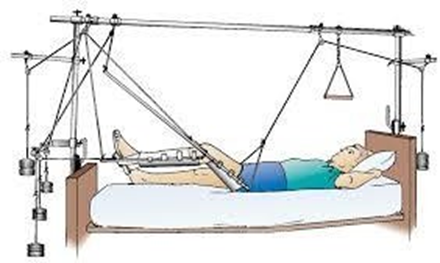A client with a fracture of the right femur has had skeletal traction applied. Which intervention should the nurse include in the client's nursing care plan?
Assess the pin sites for signs of infection.
Administer pain medication at designated intervals around the clock.
Assess the pulses proximal to the fracture site.
Remove traction every shift and provide skin care.
The Correct Answer is A
A. Assessing the pin sites for signs of infection is essential in clients with skeletal traction to detect any early signs of infection, such as redness, swelling, warmth, or purulent drainage. Prompt identification and management of pin site infections can prevent complications.

B. Administering pain medication at designated intervals around the clock helps to ensure adequate pain control and comfort for the client. However, this intervention alone does not specifically address the care needs related to skeletal traction.
C. Assessing the pulses proximal to the fracture site is important for monitoring circulation and detecting any signs of impaired perfusion. However, this assessment is not directly related to the care of skeletal traction itself.
D. Removing traction every shift is not indicated unless there is a specific reason to do so as ordered by the healthcare provider. Continuous traction is often necessary for proper alignment and stabilization of the fracture. Additionally, providing skin care is important to prevent skin breakdown around the traction device, but removing traction every shift is not part of routine care.
Nursing Test Bank
Naxlex Comprehensive Predictor Exams
Related Questions
Correct Answer is ["125"]
Explanation
To calculate the infusion rate in mL/hr, you would convert the total volume of lactated Ringer's IV from liters to milliliters (since there are 1,000 milliliters in a liter, 3 liters is equivalent to 3,000 milliliters) and then divide by the total number of hours over which the infusion is to be administered. In this case, 3,000 mL divided by 24 hours results in an infusion rate of 125 mL/hr.
Correct Answer is B
Explanation
A. Alternating IV and IM analgesic medications may be appropriate for pain management in some situations but is not the best initial intervention for continuous, severe pain in a client with stage IV bone cancer.
B. Administering opioid and non-opioid medication simultaneously is an appropriate intervention for managing severe pain, as it addresses pain from multiple pathways and may provide more effective pain relief.
C. Giving maximum dosage when the pain score reaches 10 is not recommended, as it may lead to overmedication and increased risk of adverse effects. Pain management should be based on the client's reported pain intensity and individualized needs.
D. Educating the client on signs and symptoms of narcotic dependency is important but is not the priority intervention in this situation. Pain management and relief should be the immediate focus for the client's comfort and quality of life.
Whether you are a student looking to ace your exams or a practicing nurse seeking to enhance your expertise , our nursing education contents will empower you with the confidence and competence to make a difference in the lives of patients and become a respected leader in the healthcare field.
Visit Naxlex, invest in your future and unlock endless possibilities with our unparalleled nursing education contents today
Report Wrong Answer on the Current Question
Do you disagree with the answer? If yes, what is your expected answer? Explain.
Kindly be descriptive with the issue you are facing.
